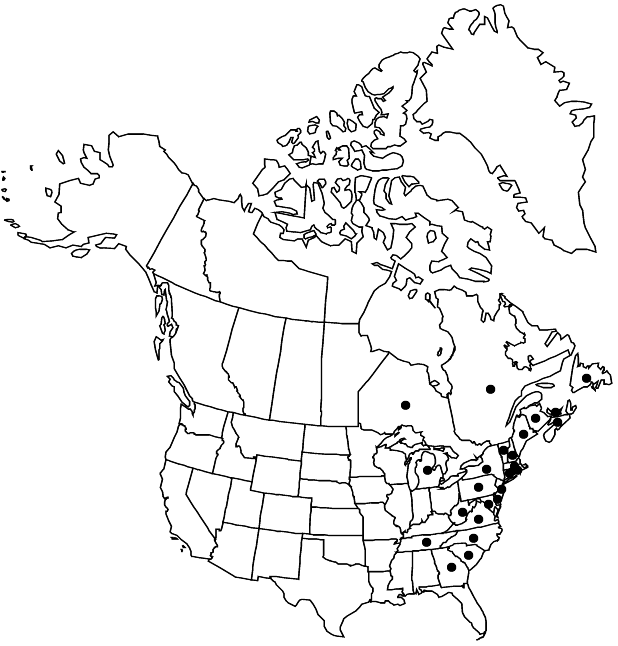Difference between revisions of "Kalmia angustifolia"
Sp. Pl. 1: 391. 1753 ,.
FNA>Volume Importer |
RevisionBot (talk | contribs) m (Bot: Adding category Revised Since Print) |
||
| (4 intermediate revisions by 3 users not shown) | |||
| Line 7: | Line 7: | ||
}} | }} | ||
|common_names=Sheep laurel;lambkill | |common_names=Sheep laurel;lambkill | ||
| + | |special_status={{Treatment/ID/Special_status | ||
| + | |code=W | ||
| + | |label=Weedy | ||
| + | }}{{Treatment/ID/Special_status | ||
| + | |code=E | ||
| + | |label=Endemic | ||
| + | }} | ||
|basionyms= | |basionyms= | ||
|synonyms={{Treatment/ID/Synonym | |synonyms={{Treatment/ID/Synonym | ||
| Line 23: | Line 30: | ||
-->{{Treatment/Body | -->{{Treatment/Body | ||
| − | |distribution= | + | |distribution=N.B.;N.S.;Nfld. and Labr. (Nfld.);Ont.;P.E.I.;Que.;Conn.;Del.;Ga.;Maine;Mass.;Md.;Mich.;N.C.;N.H.;N.J.;N.Y.;Pa.;R.I.;S.C.;Tenn.;Va.;Vt.;W.Va.;introduced in n Europe. |
|discussion=<p>Varieties 2 (2 in the flora).</p><!-- | |discussion=<p>Varieties 2 (2 in the flora).</p><!-- | ||
--><p>The two varieties of <i>Kalmia angustifolia</i> are largely separate geographically and show different flavonoid profiles (S. Liu 1993). Southeastern Virginia has long been known as a region of overlap of these two entities; field and herbarium work (B. A. Sorrie and A. S. Weakley, unpubl.) has demonstrated that the two taxa retain their distinctiveness and that hybrids are rare. Sorrie and Weakley concluded that the two should be treated as separate species.</p> | --><p>The two varieties of <i>Kalmia angustifolia</i> are largely separate geographically and show different flavonoid profiles (S. Liu 1993). Southeastern Virginia has long been known as a region of overlap of these two entities; field and herbarium work (B. A. Sorrie and A. S. Weakley, unpubl.) has demonstrated that the two taxa retain their distinctiveness and that hybrids are rare. Sorrie and Weakley concluded that the two should be treated as separate species.</p> | ||
| Line 54: | Line 61: | ||
|basionyms= | |basionyms= | ||
|family=Ericaceae | |family=Ericaceae | ||
| − | |distribution= | + | |distribution=N.B.;N.S.;Nfld. and Labr. (Nfld.);Ont.;P.E.I.;Que.;Conn.;Del.;Ga.;Maine;Mass.;Md.;Mich.;N.C.;N.H.;N.J.;N.Y.;Pa.;R.I.;S.C.;Tenn.;Va.;Vt.;W.Va.;introduced in n Europe. |
|reference=None | |reference=None | ||
|publication title=Sp. Pl. | |publication title=Sp. Pl. | ||
|publication year= | |publication year= | ||
| − | |special status= | + | |special status=Weedy;Endemic |
| − | |source xml=https:// | + | |source xml=https://bitbucket.org/aafc-mbb/fna-data-curation/src/2e0870ddd59836b60bcf96646a41e87ea5a5943a/coarse_grained_fna_xml/V8/V8_940.xml |
|subfamily=Ericaceae subfam. Ericoideae | |subfamily=Ericaceae subfam. Ericoideae | ||
|genus=Kalmia | |genus=Kalmia | ||
| Line 65: | Line 72: | ||
}}<!-- | }}<!-- | ||
| − | -->[[Category:Treatment]][[Category:Kalmia]] | + | --> |
| + | |||
| + | [[Category:Treatment]] | ||
| + | [[Category:Kalmia]] | ||
| + | [[Category:Revised Since Print]] | ||
Latest revision as of 17:16, 6 November 2020
Shrubs erect, 0.3–1.5 m. Twigs terete, viscid, glabrous or puberulent. Leaves usually in whorls of 3, rarely alternate or opposite; petiole 6–16 mm, usually puberulent; blade oblong to elliptic-lanceolate, 1.5–8 × 0.5–2.5 cm, margins usually plane, apex obtuse to acute, usually apiculate, abaxial surface glabrous or puberulent, sometimes stipitate-glandular, adaxial lightly puberulent (hairs white, to 0.1 mm), sometimes glabrescent, midrib puberulent. Inflorescences axillary near distal end, corymbiform racemes, 4–12-flowered. Pedicels 5–20 mm. Flowers: sepals usually green, sometimes reddish apically or throughout, ovate, 2–2.8 mm, apex usually acuminate, surfaces puberulent; petals connate nearly their entire lengths, usually reddish purple to pink, rarely white or bluish pink, usually deeper colored near anther pockets and with ring of red to purple spots just proximal to pockets, 7.5–9.5 × 6–13 mm, abaxial surface puberulent, adaxial glabrous, puberulent toward base; filaments 2.5–3.5 mm; style 3.5–4.5 mm. Capsules 5-locular, 2–3.5 × 3–5 mm, puberulent, stipitate-glandular. Seeds winged, obovoid, 0.6–1 mm. 2n = 24.
Distribution

N.B., N.S., Nfld. and Labr. (Nfld.), Ont., P.E.I., Que., Conn., Del., Ga., Maine, Mass., Md., Mich., N.C., N.H., N.J., N.Y., Pa., R.I., S.C., Tenn., Va., Vt., W.Va., introduced in n Europe.
Discussion
Varieties 2 (2 in the flora).
The two varieties of Kalmia angustifolia are largely separate geographically and show different flavonoid profiles (S. Liu 1993). Southeastern Virginia has long been known as a region of overlap of these two entities; field and herbarium work (B. A. Sorrie and A. S. Weakley, unpubl.) has demonstrated that the two taxa retain their distinctiveness and that hybrids are rare. Sorrie and Weakley concluded that the two should be treated as separate species.
Selected References
None.
Key
| 1 | Calyces densely stipitate-glandular; leaf blade surfaces glabrous or scattered, stipitate-glandular trichomes. | Kalmia angustifolia var. angustifolia |
| 1 | Calyces usually not stipitate-glandular; leaf blade surfaces densely puberulent abaxially, usually not stipitate-glandular. | Kalmia angustifolia var. carolina |